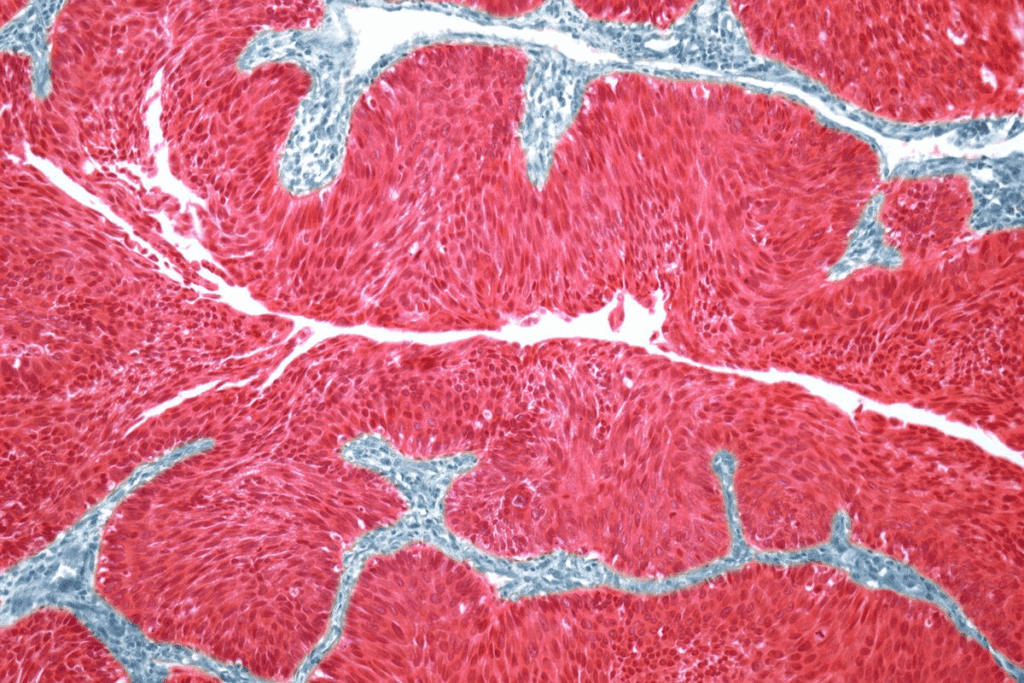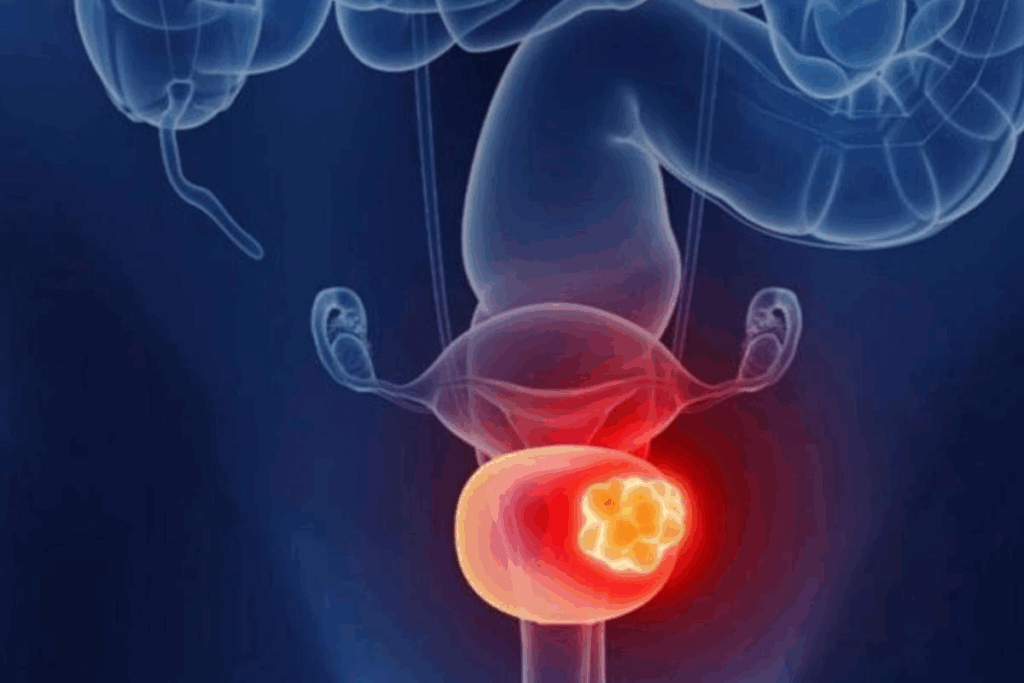Last Updated on November 25, 2025 by Ugurkan Demir

Seeing blood in your urine can be scary. But knowing the early signs of bladder cancer helps you get medical help fast. Early detection can lead to a 96 percent survival rate.See early stage stage 1 bladder cancer pictures from cystoscopy. Learn to recognize the visual signs of bladder cancer at its earliest stage.
At Liv Hospital, we stress the need to know the symptoms of stage 1 bladder cancer. Blood in your urine is usually the first sign. Other changes in your urine can also mean you have this disease.
We focus on you at Liv Hospital, giving you the best care for your urological needs. Knowing the early symptoms of bladder cancer is the first step to getting the right treatment.

When bladder cancer is diagnosed at stage 1, it’s a chance for early action. At this point, the cancer is in its early stages. Knowing its details is key for managing it well.
Stage 1 bladder cancer means cancer cells have grown into the tissue under the bladder lining. But they haven’t reached the muscle layer yet. This detail is important because it helps decide how to treat the cancer and what to expect.
The TNM system is used to stage bladder cancer. It looks at the tumor’s size and spread, nearby lymph nodes, and if the cancer has spread. Stage 1 is T1, showing the tumor has grown into the lamina propria but not the detrusor muscle.
Key Characteristics of Stage 1 Bladder Cancer:
Knowing how stage 1 bladder cancer is different from other stages is important. The main difference is how far the tumor has spread.
| Stage | Description |
| Stage 0 | Cancer cells are found only in the lining of the bladder. |
| Stage 1 | Cancer cells have invaded the connective tissue beneath the bladder lining. |
| Stage 2 | Cancer cells have invaded the muscle layer of the bladder. |
| Stage 3 | Cancer cells have invaded the layer of fat around the bladder. |
| Stage 4 | Cancer cells have spread to distant parts of the body. |
A study in a medical journal highlights the importance of accurate staging. “The accurate staging of bladder cancer is critical for choosing the right treatment and improving patient outcomes.”
“Accurate staging is essential for the management of bladder cancer, as it directly influences treatment decisions and patient prognosis.”
A renowned oncologist
Understanding stage 1 bladder cancer helps patients and doctors create a treatment plan. This plan is tailored to the cancer’s specific needs.

Blood in the urine, known as hematuria, is often the first sign of bladder cancer. It can be scary, and knowing what it means is key for early treatment.
Hematuria shows up in different ways. It’s important to know these signs to get medical help fast.
When you can see blood in your urine, it’s called visible hematuria. The urine might look pink, red, or brown. Sometimes, you might see clots.
Visible hematuria is a serious sign that needs quick doctor’s attention.
Microscopic hematuria is when lab tests find blood in urine, but you can’t see it. It doesn’t change the urine’s color.
This type is often found during routine tests or when checking for other health issues.
Blood in urine can look different. It might be a light pink, deep red, or brown. Sometimes, the urine looks cloudy or rusty.
| Type of Hematuria | Visibility | Possible Causes |
| Visible Hematuria | Noticeable to the naked eye | Bladder cancer, kidney stones, infection |
| Microscopic Hematuria | Detectable only through lab tests | Bladder cancer, urinary tract infection, kidney disease |
Knowing about the different types of hematuria helps people get medical help fast. This can lead to early detection and treatment of bladder cancer.
Urinary changes are a common early warning sign of bladder cancer. They need quick medical attention. As bladder cancer grows, patients face various urinary symptoms. These symptoms can greatly affect their quality of life.
One key urinary change with bladder cancer is needing to urinate more often. Patients may feel a strong need to go, even when they don’t. This can happen more times than usual.
Nocturia, or needing to urinate at night, is another symptom. It can disrupt sleep and affect overall health. Waking up many times to urinate can be tough.
Painful urination, or dysuria, is a symptom of bladder cancer. The pain can feel like burning or discomfort in the urinary tract. It’s a sign that needs medical attention.
These urinary changes and discomforts are important signs to see a doctor. If you’re experiencing any of these symptoms, get medical help right away. A healthcare professional can evaluate and diagnose you properly.
Bladder cancer can cause more than just common signs. Patients may feel other physical discomforts. Hematuria and changes in urine are key signs, but there’s more.
Pelvic discomfort is a symptom of bladder cancer. It can feel like a dull ache or sharp pain in the pelvic area. It’s important to note that pelvic pain can have many causes. But, if you have it with other urinary symptoms, it might mean bladder cancer.
Lower back pain is another symptom some bladder cancer patients feel. This pain can come from the tumor pressing on nearby areas or the body’s reaction to the cancer. While back pain is common, it’s a sign to see a doctor if you have urinary symptoms too.
Some people with bladder cancer don’t show symptoms, known as asymptomatic bladder cancer. In these cases, the cancer might be found during tests for other reasons. Regular health checks and screenings are key for early detection, mainly for those at higher risk.
Key Points to Remember:
It’s key to know what early bladder cancer looks like to diagnose it right. We’ll see how cystoscopy helps spot tumors in stage 1 bladder cancer.
Early bladder tumors show up as small growths on the bladder lining during cystoscopy. These can be papillary or sessile. Papillary tumors are more common in early-stage bladder cancer.
Papillary tumors look like fingers, while sessile tumors are flat and wider. Sessile tumors are often more aggressive.
Bladder tumors can look very different. They might be red or pink and even have a cauliflower-like shape. The area around the tumor might look normal or inflamed.
At times, the tumor might have dead tissue on it, changing how it looks. The color and look of the tumor depend on its blood supply and dead areas.
The size and where the tumor is matter a lot for bladder cancer diagnosis. Early tumors are usually small, under 1 cm.
Where the tumor is in the bladder also gives clues. Tumors near the bladder neck or hard to reach might need special treatments.
Looking at the tumor’s size and location during cystoscopy helps doctors understand the disease. They can then plan the best treatment.
Many people with bladder cancer notice similar early signs. These stories show how key it is to spot these signs early and get medical help fast.
Hematuria, or blood in the urine, is a common first sign. It can be seen with the eye or found in a lab test. Other symptoms include:
These signs can also mean other urinary problems. So, seeing a doctor is very important for a correct diagnosis.
How symptoms get worse can differ a lot. Some people see big changes fast, while others notice small changes over time. A typical path might be:
Knowing this timeline helps both patients and doctors spot problems sooner.
Misdiagnosis is a big problem for bladder cancer patients. Symptoms can look like other, less serious issues. It’s vital for patients to speak up if they feel their concerns are ignored.
“I was first treated for a UTI, but my symptoms didn’t go away. It wasn’t until I had a cystoscopy that I was diagnosed with bladder cancer.” – A bladder cancer patient shared this.
These stories highlight the need for detailed tests and patient advocacy.
By sharing these experiences and symptoms, we can spread the word about bladder cancer’s early signs. And why getting medical help quickly is so important.
If you notice unusual symptoms in your urine, it’s important to know when to see a doctor. Early detection and treatment are key for bladder cancer. We’ll help you know when to visit a doctor, based on symptoms and risk factors. We’ll also guide you on how to prepare for your appointment.
Some symptoms need quick medical attention. Hematuria, or blood in the urine, is a common sign of bladder cancer. If you see blood or have frequent infections, see a doctor right away. Other symptoms to watch for include:
One patient said, “I had been experiencing persistent hematuria for months before I decided to see a doctor.” Spotting these symptoms early can greatly improve treatment results.
Knowing your risk factors helps decide when to start bladder cancer screening. Key risk factors include:
If you have any of these risk factors, talk to your doctor about screening. The American Cancer Society says, “knowing your risk factors helps you and your doctor choose the best screening plan.”
Getting ready for your appointment is a good idea. Make a list of your symptoms and when they started. Also, think about any risk factors you might have. Here are some tips:
Being prepared ensures a helpful conversation with your doctor. This way, you can make informed decisions about your health.
Early detection is key to managing bladder cancer. Advanced diagnostic procedures help find the disease early. This makes treatment more effective.
Cystoscopy is a vital test for bladder cancer. A thin, flexible tube with a camera is inserted through the urethra. This lets doctors see inside the bladder for tumors or other issues.
The patient gets local anesthesia to feel less pain. The cystoscope allows for a detailed look. It can spot tumors that imaging tests might miss.
Urine cytology checks urine samples under a microscope for cancer cells. Biomarker tests look for proteins or genetic markers in urine that might show bladder cancer.
These tests are easy and can give important clues about cancer. Urine cytology finds cancer cells. Biomarker tests find specific markers for bladder cancer.
CT scans, MRI, and ultrasound are key for diagnosing bladder cancer. They give detailed images of the bladder and nearby tissues. These images help doctors understand how far the disease has spread.
Imaging tests are vital for staging bladder cancer. They help find the size and location of tumors. They also check if cancer has spread to other areas.
| Diagnostic Test | Description | Purpose |
| Cystoscopy | Visual examination of the bladder using a flexible tube with a camera | Directly visualize tumors or abnormalities |
| Urine Cytology | Microscopic examination of urine for cancer cells | Detect cancer cells in urine |
| Biomarker Tests | Detection of specific proteins or genetic markers in urine | Identify possible bladder cancer indicators |
| Imaging Tests (CT, MRI, Ultrasound) | Detailed imaging of the bladder and surrounding tissues | Assess the extent of the disease |
When you’re diagnosed with stage 1 bladder cancer, it’s key to know about survival rates and treatment options. Understanding your prognosis and the treatments available is vital.
Stage 1 bladder cancer is an early stage, and survival rates are good. The American Cancer Society says the 5-year survival rate is about 88% for cancers that haven’t spread beyond the bladder’s inner layer. This gives patients a positive outlook.
Getting a cancer diagnosis can be scary, but knowing the stats can help. Survival rates can change based on your health, age, and how well you respond to treatment.
TURBT is a main treatment for stage 1 bladder cancer. It removes the tumor from the bladder wall using a special scope. This method is both diagnostic and therapeutic, helping doctors understand the tumor while removing it.
Key aspects of TURBT include:
After TURBT, intravesical therapy might be suggested to lower cancer recurrence risk. This involves putting medication directly into the bladder through a catheter. Common therapies include Bacillus Calmette-Guérin (BCG) and Mitomycin C.
BCG therapy is a top choice for high-risk non-muscle invasive bladder cancer. It boosts the immune system to fight cancer cells. Mitomycin C is a chemotherapy drug that targets cancer cells in the bladder.
| Therapy Type | Mechanism | Common Usage |
| BCG Therapy | Stimulates immune response | High-risk non-muscle invasive bladder cancer |
| Mitomycin C | Chemotherapy | Non-muscle invasive bladder cancer |
After treatment, regular follow-ups are key to watch for recurrence and manage side effects. This includes cystoscopy exams, urine tests, and imaging. How often you need these checks depends on your risk factors and treatment response.
Following the recommended follow-up schedule is vital. It helps catch any recurrence early and keeps you healthy.
Spotting bladder cancer early is key to better treatment and outcomes. We’ve talked about the main signs, like blood in urine, changes in how you pee, and pain. We also looked at how to diagnose and treat stage 1 bladder cancer.
Early detection is vital for better survival rates and quality of life. Knowing the symptoms and risk factors helps people get medical help fast. This leads to better health outcomes.
We need to keep learning and spreading the word about bladder cancer. This helps those affected and encourages a healthy lifestyle. Together, we can improve the lives of bladder cancer patients and their families.
The main sign of stage 1 bladder cancer is blood in the urine. This can be seen with the eye or found in lab tests.
Blood in urine can make it look pink, red, or cola-colored. Sometimes, it looks normal but lab tests can find tiny amounts of blood.
People with bladder cancer might pee more often and feel a strong need to go. They might also pee at night and feel pain when they pee. These changes can really affect daily life.
Yes, some people might feel pain in their pelvis and lower back. But, bladder cancer can also have no symptoms at all.
Doctors use a cystoscopy to look inside the bladder for tumors. They might also do urine tests and imaging to help diagnose.
Early-stage bladder cancer can look like small, raised spots or patches inside the bladder. They can be different colors and sizes, and where they are can tell doctors a lot.
For stage 1 bladder cancer, doctors often remove the tumor with a TURBT. They might also use intravesical therapy to kill any cancer cells left in the bladder.
The survival rate for stage 1 bladder cancer is usually very good, thanks to early detection and treatment. The exact rate can vary, but catching it early makes a big difference.
How often you need follow-up appointments depends on your situation. But, regular check-ups are important to watch for any signs of cancer coming back.
If you notice blood in your urine, pee more often, or feel pain when you pee, see a doctor right away. Early diagnosis is key to treating bladder cancer effectively.
National Health Service (NHS). (2025). What Are the Early Signs of Stage 1. Retrieved from https://www.nhs.uk/conditions/bladder-cancer/symptoms/
Subscribe to our e-newsletter to stay informed about the latest innovations in the world of health and exclusive offers!